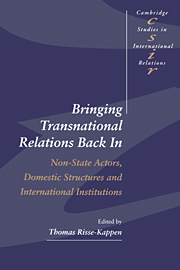 Bringing Transnational Relations Back In
Bringing Transnational Relations Back In Published online by Cambridge University Press: 02 December 2009
Introduction
Transnational relations, i.e., regular interactions across national boundaries when at least one actor is a non-state agent or does not operate on behalf of a national government or an intergovernmental organization, permeate world politics in almost every issue-area. About 5,000 international non-governmental organizations (INGOs) – from Amnesty International and Greenpeace to the International Political Science Association – lobby international regimes and inter-state organizations for their purposes. Some promote international cooperation, while others try to prevent regulatory regimes which would interfere with the activities of private citizens. Some of the approximately 7,000 multinational corporations (MNCs) with subsidiaries in other countries have gross sales larger than the gross national product (GNP) of even major countries and, thus, create adaptation problems for the foreign economic policies of many states. More loosely organized transnational alliances appear to be everywhere, too. Transnational dissident movements in Eastern Europe helped to topple the Communist regimes in 1989. Western social movements set the public agenda on peace and environmental questions in many countries during the 1980s. Transnational groups of scientists – “epistemic communities” – contributed to a growing global awareness about various environmental issues. Transgovernmental networks among state officials in sub-units of national governments, international organizations, and regimes frequently pursue their own agenda, independently from and sometimes even contrary to the declared policies of their national governments. Such knowledge-based or normative principle-based transnational and transgovernmental issue networks seem to have a major impact on the global diffusion of values, norms, and ideas in such diverse issue-areas as human rights, international security, or the global environment.
To save this book to your Kindle, first ensure no-reply@cambridge.org is added to your Approved Personal Document E-mail List under your Personal Document Settings on the Manage Your Content and Devices page of your Amazon account. Then enter the ‘name’ part of your Kindle email address below. Find out more about saving to your Kindle.
Note you can select to save to either the @free.kindle.com or @kindle.com variations. ‘@free.kindle.com’ emails are free but can only be saved to your device when it is connected to wi-fi. ‘@kindle.com’ emails can be delivered even when you are not connected to wi-fi, but note that service fees apply.
Find out more about the Kindle Personal Document Service.
To save content items to your account, please confirm that you agree to abide by our usage policies. If this is the first time you use this feature, you will be asked to authorise Cambridge Core to connect with your account. Find out more about saving content to Dropbox.
To save content items to your account, please confirm that you agree to abide by our usage policies. If this is the first time you use this feature, you will be asked to authorise Cambridge Core to connect with your account. Find out more about saving content to Google Drive.